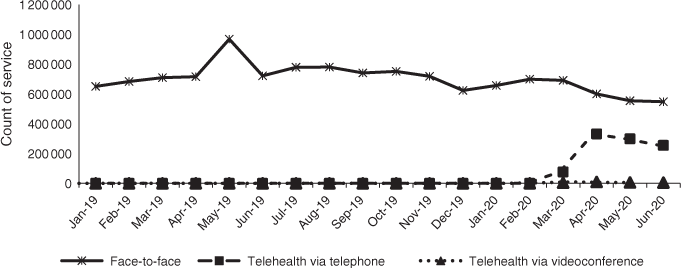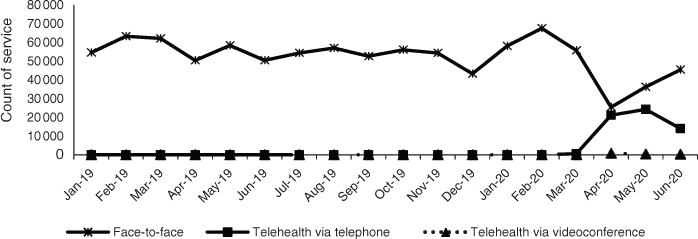Experiences of patients with chronic diseases of access to multidisciplinary care during COVID-19 in South Australia
Sara Javanparast A , Leigh Roeger A and Richard L. Reed A B
A , Leigh Roeger A and Richard L. Reed A B
A Department of General Practice, College of Medicine and Public Health, Flinders University, Adelaide, SA, Australia. Email: sara.javanparast@flinders.edu.au; leigh.roeger@flinders.edu.au
B Corresponding author. Email: richard.reed@flinders.edu.au
Australian Health Review 45(5) 525-532 https://doi.org/10.1071/AH20328
Submitted: 18 November 2020 Accepted: 14 February 2021 Published: 20 May 2021
Journal Compilation © AHHA 2021 Open Access CC BY
Abstract
Objective This study investigated the experience of patients with chronic diseases regarding access to and utilisation of multidisciplinary care during COVID-19 in South Australia.
Methods Telephone interviews were conducted with 30 patients with chronic conditions attending nine general practices in metropolitan Adelaide. Supplementary data were obtained from the Medicare Benefit Schedule (MBS) to compare health services activity data provided by different health professionals before and after COVID-19 (from January 2019 to June 2020).
Results There was variation in access to different health services by patients with chronic conditions during COVID-19. The introduction of telehealth facilitated continuity of general practitioner (GP) services, with a high level of satisfaction among patients. Changes in medicines regulation, including the home delivery of medications, enabled timely access to medications for patients. The use of telehealth was less common for specialist and particularly allied health services. Dental check-ups that are important for the management of some chronic conditions were disrupted the most during COVID-19.
Conclusion The findings of this study suggest that the policy measures introduced in Australia provided an opportunity to maintain multidisciplinary care for patients with chronic diseases during COVID-19. GPs, as core members of the primary healthcare team, as well as pharmacy and pathology services, were highly accessible. Telehealth was less accessed for chronic care services provided by specialists and allied health professionals.
What is known about the topic? Access to multidisciplinary care is critical to ensure continuity and quality of care for patients with chronic health conditions. Evidence suggests disruptions in health services can occur during pandemics. To continue access to routine care, the Australian Government introduced several policy initiatives during COVID-19 to enhance access to multidisciplinary care.
What does this paper add? Telehealth policy was particularly effective in facilitating patients’ access to general practice services during COVID-19 particularly those services that did not need physical examinations. This policy complemented changes in medicines regulations that enabled timely and convenient access to medications for patients with chronic conditions. Allied health services, as important elements of multidisciplinary care, were more likely to be disrupted during COVID-19.
What are the implications for practitioners? Continuation of telehealth services is likely to enhance access to general practice services. The acceptability and use of telehealth for allied health services may require more flexibility, and training for both practitioners and patients.
Keywords: chronic disease management, pandemic, consumers, health services, COVID-19, multidisciplinary care, Australia, telehealth, qualitative study.
Introduction
Patients with chronic diseases often require multidisciplinary care, provided by a team of health professionals,1 to optimise continuity, coordination and quality of care, and to improve health outcomes.2 Different integrated models of care are advocated to improve the prevention and treatment of chronic diseases.3–5 In Australia, initiatives to support multidisciplinary care for chronic disease management have been developed, including federal funding (e.g. Medicare Benefit Schedule (MBS)-subsidised items for chronic disease management and funding for services provided by allied health professionals).6
Communication between providers, health system structure and resources is essential for multidisciplinary care to be effective.7 In emergencies, the diversion of health resources, disruption in routine care and increased stress can make chronic disease management more challenging,8,9 and this may be evident in the current COVID-19 pandemic in Australia. Disruption to access to multidisciplinary care is likely to put patients with chronic diseases at higher risk of complications and death from COVID-19 and/or from their chronic diseases.8
To ensure access to routine care, on 11 March 2020 the Australian Government introduced a pandemic funding package of A$2.4 billion to provide support across primary care, aged care, hospitals, research and the national medical stockpile.10 The key policy measures related to chronic disease management are described below.
Extended access to telehealth services
In March 2020, MBS telehealth items were made available to general practitioners (GPs), allied health providers and medical specialists where patients or health providers were from vulnerable groups.11 Telehealth was then expanded to all Australians and to a broader range of services, including chronic disease management.12 Changes in April 2020 allowed health providers to apply their usual billing practice to new telehealth services.13 Further changes in July 2020 reinforced patient–practitioner relationships and restricted MBS-subsidised telehealth services to only those who have had a face-to-face consultation with their regular GP or another medical or health professional at the same practice at least once in the previous 12 months.14 The telehealth MBS items have been extended until the end of 2021.15
Changes to medicines regulation
There were government announcements to ensure Australians, particularly older people and those with chronic diseases, can access Pharmaceutical Benefits Scheme (PBS) medicines during COVID-19. These announcements included: (1) arrangements for the ongoing supply of medicines without the need for a new prescription from the doctor; (2) substituting dose strengths or forms of medicines by pharmacists without prior approval from the doctor if a medicine was unavailable at the time of dispensing; (3) home delivery services allowing vulnerable people to obtain a script remotely from their doctor (via telehealth), have their scripts filled remotely and delivered to their home; and (4) restrictions on the quantity of medicines that could be purchased to prevent unnecessary medicine stockpiling.16 Many of these measures had originally commenced in January 2020 as a result of Australian bushfire crisis, but were extended during the COVID-19 pandemic.
Restrictions in dental care services
In March 2020, the Australian Government placed Level 3 restrictions on dentists across the country, limiting dentists to only perform dental treatments that generate no or limited aerosols. The Australian Government also recommended that all routine examinations, treatments and non-urgent dental care should be deferred,17 resulting in the closure of many dental clinics during the peak of the COVID-19 crisis. Some dentists willing to perform urgent and emergency dental services were registered to continue services. New telehealth MBS items have been introduced for dental practitioners practicing oral or maxillofacial surgery.11
Continued operation of the National Pathology Accreditation Program
The Australian Government committed some measures to support pathology laboratories in the provision of services, particularly during the high-demand period of the COVID-19 pandemic. These measures included the renewal of accreditation for 6 months for those pathology laboratories whose accreditation approvals were to cease within 6 months, and remote or virtual assessment of laboratories and supervisory visits.18
There are limited studies examining the uptake and acceptability of these services by people at higher risk of poor health outcomes. This study investigated the experience of patients with chronic diseases on access to and the utilisation of multidisciplinary care during COVID-19.
Methods
Telephone interviews
Semistructured telephone interviews were conducted with 30 patients from nine general practices in metropolitan Adelaide (May–June 2020). Participants recruited in this study were former participants of a clinical trial of enhanced general practice services (Flinders Quality Enhanced General Practice Services Trial – QUEST) conducted in 2019 (study not yet published). Flinders QUEST was designed as a randomised control trial in partnership with 20 general practices (10 intervention, 10 control practices) in Adelaide, South Australia. The trial aimed to assess the effectiveness and cost-effectiveness of four enhanced services, namely a patient’s enrolment to a preferred GP, longer appointment time, improved patient follow-up after hospitalisation and same-day appointments for children and young people. Adult patients in the trial were selected from two cohorts: adults aged 18–64 years with two or more chronic diseases and people aged ≥65 years. Both groups were regular patients at the practice and had been identified as at high risk of poor health outcomes by their GPs for the clinical trial. The trail evaluation (undertaken by the first author, SJ) involved interviews with 45 adults who expressed an interest in further contact by the research team.
Of 45 adult patients participating in the Flinders QUEST evaluation, 33 potential participants were approached from 10 intervention practices for the present study; an invitation letter was mailed out to them, followed by a telephone call 1 week after the mail-out. Thirty people from nine practices agreed to participate in the study (i.e. three to four patients per practice), and a telephone interview was arranged for each individual participant. Three people declined to take part in the study due to sickness or other personal matters. An interview guide was developed by the team and included questions on participants’ experiences with access to general practice, specialist, allied health, dental and pathology services and factors that enabled or constrained health care access, including telehealth, during COVID-19 (Supplementary File S1). Interviews were conducted by the first author (SJ), an experienced female qualitative researcher, and took approximately 20–30 min.
Participants provided verbal consent for study participation and for the recording of interviews. Interviews were transcribed verbatim and imported into NVivo-12 software (QSR International) for data management and thematic analysis. A coding structure was developed based on deductive and inductive codes from the research questions and any additional concepts emerging from the interviews. The data were analysed by the first author.
This study was approved by the Southern Adelaide Clinical Human Research Ethics Committee (114.20).
MBS data analysis
The interviews were complemented with MBS data sources. These data are publicly available from the MBS website (http://medicarestatistics.humanservices.gov.au/statistics/mbs_item.jsp) and include: (1) activity data on the type of service and item number (e.g. general practice or specialist service) performed by a registered health provider and for services that qualify for a Medicare benefit in primary health care settings; and (2) a count of services provided by health professional in a specific time period (e.g. in months, quarters or in a calendar year) in each Australian state and territory. The MBS website also includes financial data (Medicare contribution to service) for each of these services. In the present study, we only used activity data (count of services). Activity data in South Australia were obtained for: standard GP and other medical practitioner (OMP) attendance; GP and OMP chronic disease management; allied health chronic disease management; chronic disease management by a nurse or Aboriginal and Torres Strait Islander practitioner; and specialist and consultant physician services.
The MBS website creates reports comparing the count of services for selected health providers, and states and territories, within a selected time period. We used the MBS descriptive reports to compare activity data for 1.5 years (January 2019–June 2020) for each of these services. The uptake of telehealth (via telephone and videoconferencing) was examined from the introduction of COVID-19 MBS items in March 2020.
Results
Interview participants (n = 30; 17 females, 13 males) were aged between 54 and 88 years. The interviews revealed variation in access to and the utilisation of different health services during COVID-19.
GP services
Participants greatly valued continued access to GP services during COVID-19. Of 30 participants, 25 reported consultations, either face-to-face or by telephone, with their GPs (on average two to three times between March and June 2020) and felt that the frequency remained the same since the pandemic started in South Australia in March–April 2020. Offering telehealth was a major factor enabling access to GP services. Of the five who did not have GP consultations, three did not feel the need for such consultations and two, because of their health conditions, preferred face-to-face visits. All telehealth services were via telephone, with none conducted via videoconferencing. Participants expressed a positive experience with telehealth, particularly for issues such as prescription renewal, discussing test results and simple chronic condition follow-up:
If it’s just for my [chronic disease] check-up, I don’t see why that [telehealth] would be a problem because I do my own blood pressure, blood sugar and all that sort of thing, and he could email me or fax me any paperwork, like tests and then talk to me over the phone. (Male, 65 years old)
Participants appreciated the opportunity for face-to-face GP consultations if these were required to complement telehealth:
I had my care plan with my GP and the nurse, and he [my GP] actually wanted me to come in so I went to the practice which was very good. He just said, ‘Yeah, come in.’ (Female, 54 years old)
Specialist services
Fewer than half the interview participants reported consultations with specialists during COVID-19. Specialist appointments were more likely to be cancelled or postponed unless there was an urgent need. Telehealth was also less offered by specialists or accepted by patients:
I’ve had specialists’ appointments cancelled…They didn’t offer that [telephone consultation] at all. (Male, 88 years old)
I just thought well I really don’t need to go to the specialist right now, I’ll wait till afterwards. (Male, 77 years old)
That was a phone consult with the specialist I had…Absolutely useless. I had a shoulder reconstruction last September and I had to go back to for review…How can you review my shoulder on a phone? Especially when you have private health and paying so much money to see an orthopaedic surgeon. (Female, 70 years old)
Allied health services
Participants reported disruptions to allied health services during COVID-19, with many services closing completely or with appointments cancelled or postponed. Participants felt telehealth was not appropriate for some allied health services, such as physiotherapy, podiatry or chiropractic:
As for the physio, I think it’s a complete waste of time because without face to face you can’t really determine that you’re doing things right. (Male, 66 years old)
But the one thing that did change was access to chiropractic. I haven’t attended my chiropractic since the shutdown…but that has been an impact because I do find that I’ve had neck ache and backache because I haven’t been to the chiropractor for my regular adjustments. (Female, 67 years old)
Dental care services
Of eight participants who needed dental services, only three were able to receive services they needed during COVID-19. In general, there was a negative view on the availability of dental services, with most appointments having to be cancelled or postponed:
The only thing I’ve had trouble with, I broke a tooth while this was all on and I couldn’t get into a dentist. The dentists were all closed, you couldn’t go in…to me, was a real problem. (Female, 69 years old)
One patient raised concerns about poor access to dental care as an essential component of her routine care for heart disease:
The one thing that I was really disappointed about was my dental appointment. They would only see me if it’s an emergency but to be a regular check which should be because of obviously my health issues, it always worries me that I needed my teeth to be checked to ensure nothing happening. I’ve had the valve implantation, the concern is that there’s a connection between if you got a problem with your teeth [and] a valve so that worries me. It was supposed to be April but it got cancelled and pushed out to August. (Male, 58 years old)
Pharmacy services
Pharmacy services were reported as the most satisfying and convenient services used by all participants in the study. Telehealth provided the opportunity for electronic prescriptions when the participants did not need to visit their GP. The home delivery of medications was reported as a measure that worked effectively, although some declined the offer if they were able to self-collect medications from the pharmacy:
My GP wrote a script and faxed it to the chemist. And the chemist would deliver to me. Very convenient. (Female, 79 years old)
I get the blister packs, which is very convenient. It keeps me away from the chemist or anywhere else for two weeks at a time, so I find it very convenient to have a blister pack. (Male, 88 years old)
Pathology services
Participants experienced little change in the way pathology services were provided during COVID-19. Almost all participants used pathology services through their general practice or pathology centres. This was complemented by telehealth, which enabled communication between GPs and patients to discuss test results via the telephone:
I did have to do blood tests and a urine sample, and that was taken in. With our GP practice, in the same building, on the outside of the building, is the clinic that does the blood tests. So, I went there and had the blood test done the normal way, nothing changed with that. (Female, 79 years old)
The analysis of MBS activity data supported our interview findings on service uptake during COVID-19. Figs 1–5 show service uptake for different health professionals over the past 1.5 years in South Australia and compare different modes of service delivery during COVID-19. A comparison of the activity data shows that while the uptake of telehealth (particularly phone consultations) significantly increased for GP services between March and April 2020, the use of telehealth for allied health services was limited.
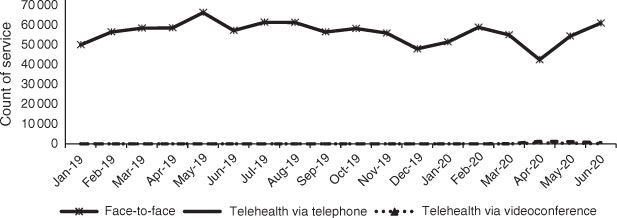
|
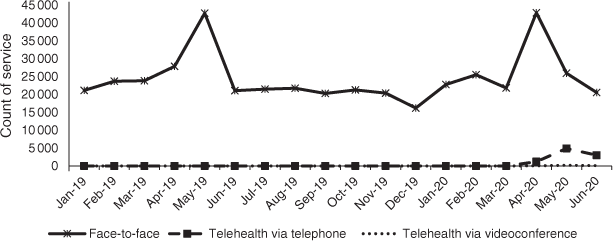
|
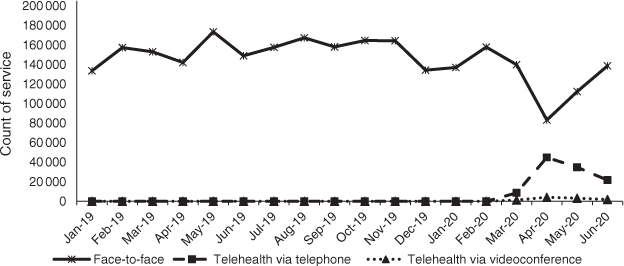
|
Table 1 summarises total activities and averages per month for different health services before and during the COVID-19 pandemic. It also compares the uptake of telehealth via telephone and videoconference, demonstrating lower rates of videoconference uptake for all health professional groups.

|
Discussion
Emergencies can have a significant effect on the provision and maintenance of multidisciplinary care required for chronic disease management.8 The Australian Government’s policy responses during COVID-19 intended to minimise health service disruptions. Interviews with patients experiencing chronic diseases in South Australia and analysis of MBS data in this study provide insights into how well these policies reached their goal in supporting chronic disease management. Several key points emerged from our study, as discussed below.
The expansion of telehealth services was a major factor facilitating continued access to health services, particularly GP services. As shown by the MBS data, there was an increase in the average number of services per month provided by GPs and other medical practitioners during COVID-19. Most participants in this study were willing to use telehealth for GP consultations and chronic disease management, with almost one-third of these services undertaken via telehealth, usually by telephone.19 The uptake was much higher during April 2020, when South Australia faced its strictest COVID-19 restrictions.
Allied health professionals are important members of the multidisciplinary team and play a crucial role in the management of chronic diseases.20 In this study, allied health services were more likely to be disrupted during COVID-19. Both interview and MBS data found that a shift to virtual care (either telephone or video) was often not viewed as appropriate for allied health services. The MBS data supported the qualitative findings, demonstrating a decrease in the mean number of allied health services per month for chronic disease management during COVID-19. However, the MBS reports lack separated activity data for various allied health professionals, and so we were unable to compare the uptake of telehealth provided by different allied health professionals. Similarly, the use of specialist care decreased during COVID-19. Further research may shed some light on factors affecting low uptake and ways to maintain access to and the utilisation of various allied health and specialist care services in pandemics.
In relation to chronic disease management services provided by practice nurses or Aboriginal and Torres Strait Islander practitioners, this study found an almost 35% increase in the monthly averages of face-to-face visits during April 2020. The interviewees frequently reported visits to practice nurses for flu vaccination during COVID-19, and this may explain the increase in practice nurse attendances. The significant increase in the rate of flu vaccinations in 2020 is consistent with data from the Australian Government’s Department of Health (2.1 million as of April 2020 vs 624 000 at the same time in 2019).21
Despite the priority given to videoconferencing in policy documents, this study found that in all professional groups the uptake of videoconferencing was very low in South Australia. The low uptake of videoconferencing indicates poor interest and acceptance, or a lack of digital literacy, for this modality among both patients and practitioners. Further research is needed to explore factors influencing clinicians’ and patients’ choices regarding the mode of communication and clinical outcomes from different delivery methods.
The comprehensive and timely supply of medications during COVID-19 and coordination between GPs and other health professionals with pharmacies are critical to ensuring patients with chronic diseases access the medications they need.22,23 The experience of patients participating in this study shows that the Australian policy response in relation to pharmacy support services, particularly electronic prescriptions via telehealth and home delivery, was highly effective in facilitating patients’ access to medications for their complex health conditions during COVID-19.
Similarly, supporting pathology services to ensure they remained operational and accessible during COVID-19 was a positive policy response in Australia, with most participants in this study reporting continued access to these services when required. Pathology services are a vital and integral part of chronic disease management where patients require ongoing monitoring through pathology tests and communication with their GPs to adjust treatment plans and medication regimes.24 Telehealth services enabled GPs to request pathology tests electronically, and this also facilitated doctor–patient communication to discuss test results, an opportunity that was appreciated by our study participants.
Our study had some limitations. Clinicians’ perspectives on using telehealth for chronic disease management are important but were not included in the study. The study was also limited in detailing factors affecting the uptake of services by health professionals involved in chronic disease management and ways to improve the effectiveness and acceptance of such services during pandemics. The study participants were recruited from metropolitan Adelaide, and thus do not represent the perspectives of patients in regional areas who may have faced other challenges in relation to the management of their chronic diseases. Furthermore, the MBS reports used in this study do not distinguish activity data in metropolitan from those in rural/remote regions, and thus the generalisability of our findings on services uptake, including telehealth, in regional areas is limited.
Conclusion
Policy measures introduced in Australia provided an opportunity for continued access to multidisciplinary care for patients with chronic diseases. GPs, as core members of the primary health care team, were highly accessible, either face-to-face or via telehealth. However, this was not the case for other members of the multidisciplinary care team. If telehealth is to be continued as a mode of service delivery for chronic disease management, further research is required to examine the utilisation of telehealth for different health providers and the factors affecting its effectiveness and acceptance by health professionals who are part of the multidisciplinary team.
Competing interests
The authors declare no competing interests.
Declaration of funding
This study was supported by internal funding from the Discipline of General Practice, College of Medicine and Public Health, Flinders University.
Acknowledgements
The authors acknowledge the participation of general practice patients in South Australia who shared with us their experience of using multidisciplinary care for chronic disease management during COVID-19. The authors also acknowledge that they have drafted a separate paper that solely focuses on the use of telehealth in general practice services; that paper is now published (see reference 19).
References
[1] Reynolds R, Dennis S, Hasan I, Slewa J, Chen W, Tian D, Bobba S, Zwar N. A systematic review of chronic disease management interventions in primary care. BMC Fam Pract 2018; 19 11| A systematic review of chronic disease management interventions in primary care.Crossref | GoogleScholarGoogle Scholar | 29316889PubMed |
[2] Harris MF, Jayasinghe UW, Taggart JR, Christl B, Proudfoot JG, Crookes PA, Beilby JJ, Powell Davies G. Multidisciplinary team care arrangements in the management of patients with chronic disease in Australian general practice. Med J Aust 2011; 194 236–9.
| Multidisciplinary team care arrangements in the management of patients with chronic disease in Australian general practice.Crossref | GoogleScholarGoogle Scholar | 21381995PubMed |
[3] Wagner EH, Austin BT, Von Korff M. Organizing care for patients with chronic illness. Milbank Q 1996; 74 511–44.
| Organizing care for patients with chronic illness.Crossref | GoogleScholarGoogle Scholar | 8941260PubMed |
[4] Nutting PA, Miller WL, Crabtree BF, Jaen CR, Stewart EE, Stange KC. Initial lessons from the first national demonstration project on practice transformation to a patient-centered medical home. Ann Fam Med 2009; 7 254–60.
| Initial lessons from the first national demonstration project on practice transformation to a patient-centered medical home.Crossref | GoogleScholarGoogle Scholar | 19433844PubMed |
[5] Dennis SM, Zwar N, Griffiths R, Roland M, Hasan I, Powell Davies G, Harris M. Chronic disease management in primary care: from evidence to policy. Med J Aust 2008; 188 S53–6.
| Chronic disease management in primary care: from evidence to policy.Crossref | GoogleScholarGoogle Scholar | 18429737PubMed |
[6] Minister for Health and Ageing. Government expands Medicare for the chronically ill. Media release, 9 June 2005. Available at: https://parlinfo.aph.gov.au/parlInfo/download/media/pressrel/M7BG6/upload_binary/m7bg62.pdf;fileType=application%2Fpdf#search=%22media/pressrel/M7BG6%22
[7] Kadu MK, Stolee P. Facilitators and barriers of implementing the chronic care model in primary care: a systematic review. BMC Fam Pract 2015; 16 12
| Facilitators and barriers of implementing the chronic care model in primary care: a systematic review.Crossref | GoogleScholarGoogle Scholar | 25655401PubMed |
[8] Hartmann-Boyce J, Mahtani KR. Supporting people with long-term conditions (LTCs) during national emergencies. Centre for Evidence-Based Medicine; 2020.
[9] Chudasama YV, Gillies CL, Zaccardi F, Coles B, Davies MJ, Seidu S, Khunti K. Impact of COVID-19 on routine care for chronic diseases: a global survey of views from healthcare professionals. Diabetes Metab Syndr 2020; 14 965–7.
| Impact of COVID-19 on routine care for chronic diseases: a global survey of views from healthcare professionals.Crossref | GoogleScholarGoogle Scholar | 32604016PubMed |
[10] Prime Minister of Australia. $2.4 billion heath plan to fight COVID-19. Media release, 11 March 2020. Available at: https://www.pm.gov.au/media/24-billion-health-plan-fight-covid-19#:~:text=The%20Australian%20Government%20has%20unveiled,coronavirus%20(COVID%2D19)
[11] Department of Health. COVID-19 temporary MBS telehealth services – factsheets on the use of the temporary MBS telehealth and phone consultation item numbers. Canberra: Australian Government; 2021. Available at: http://www.mbsonline.gov.au/internet/mbsonline/publishing.nsf/Content/Factsheet-TempBB
[12] Minister for Health and Aged Care. COVID-19: Whole of population telehealth for patients, general practice, primary care and other medical services. Media release, 29 March 2020. Available at: https://www.health.gov.au/ministers/the-hon-greg-hunt-mp/media/covid-19-whole-of-population-telehealth-for-patients-general-practice-primary-care-and-other-medical-services
[13] Minister for Health and Aged Care. Australians embrace telehealth to save lives during COVID-19. Media release, 20 April 2020. Available at: https://www.health.gov.au/ministers/the-hon-greg-hunt-mp/media/australians-embrace-telehealth-to-save-lives-during-covid-19
[14] Minister for Health and Aged Care. Continuous care with telehealth stage seven. Media release, 10 July 2020. Available at: https://www.health.gov.au/ministers/the-hon-greg-hunt-mp/media/continuous-care-with-telehealth-stage-seven
[15] Minister for Health and Aged Care. Universal telehealth extended through 2021. Media release, 26 April 2021. Available at: https://www.health.gov.au/ministers/the-hon-greg-hunt-mp/media/universal-telehealth-extended-through-2021
[16] Minister for Health and Aged Care. Ensuring continued access to medicines during the COVID-19 pandemic. Media release, 31 March 2020. Available at: https://www.health.gov.au/ministers/the-hon-greg-hunt-mp/media/ensuring-continued-access-to-medicines-during-the-covid-19-pandemic
[17] Australian Dental Association. Managing COVID-19 guidelines. 2020. Available at: https://www.ada.org.au/Managing-Covid-19-Guide
[18] Department of Health. Pathology accreditation processes during COVID-19 pandemic – stage III. Canberra: Australian Government; 2021. Available at: https://www.rcpa.edu.au/Library/COVID-19-Updates/COVID-19-Useful-Resources/Docs/Commonwealth-advice-on-response-to-COVID-path-accr.aspx
[19] Javanparast S, Roeger L, Kwok Y, Reed RL. The experience of Australian general practice patients at high risk of poor health outcomes with telehealth during the COVID-19 pandemic: a qualitative study. BMC Fam Pract 2021; 22 69
| The experience of Australian general practice patients at high risk of poor health outcomes with telehealth during the COVID-19 pandemic: a qualitative study.Crossref | GoogleScholarGoogle Scholar | 33832422PubMed |
[20] Barr ML, Welberry H, Comino EJ, Harris-Roxas BF, Harris E, Lloyd J, Whitney S, O’Connor C, Hall J, Fort Harris M. Understanding the use and impact of allied health services for people with chronic health conditions in Central and Eastern Sydney, Australia: a five-year longitudinal analysis. Prim Health Care Res Dev 2019; 20 E141
| Understanding the use and impact of allied health services for people with chronic health conditions in Central and Eastern Sydney, Australia: a five-year longitudinal analysis.Crossref | GoogleScholarGoogle Scholar | 31640837PubMed |
[21] Minister for Health and Aged Care. Record 16.5 million flu vaccines to protect Australians. Media release, 19 April 2020. Available at: https://www.health.gov.au/ministers/the-hon-greg-hunt-mp/media/record-165-million-flu-vaccines-to-protect-australians
[22] Liu S, Luo P, Tang M, Hu Q, Polidoro JP, Sun S, Gong Z. Providing pharmacy services during the coronavirus pandemic. Int J Clin Pharm 2020; 42 299–304.
| Providing pharmacy services during the coronavirus pandemic.Crossref | GoogleScholarGoogle Scholar | 32222911PubMed |
[23] Sin JH, Richards II, Ribisi MS. Maintaining comprehensive pharmacy services during a pandemic: Recommendations from a designated COVID-19 facility. Am J Health Syst Pharm 2020; 77 1522–8.
| Maintaining comprehensive pharmacy services during a pandemic: Recommendations from a designated COVID-19 facility.Crossref | GoogleScholarGoogle Scholar | 32533829PubMed |
[24] Whiting D, Croker R, Watson J, Brogan A, Walker AJ, Lewis T. Optimising laboratory monitoring of chronic conditions in primary care: a quality improvement framework. BMJ Open Qual 2019; 8 e000349
| Optimising laboratory monitoring of chronic conditions in primary care: a quality improvement framework.Crossref | GoogleScholarGoogle Scholar | 30997410PubMed |


